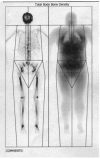Cilia, Alström syndrome--molecular mechanisms and therapeutic perspectives
- PMID: 20108502
- PMCID: PMC5654309
Cilia, Alström syndrome--molecular mechanisms and therapeutic perspectives
Abstract
Over the past ten years, several studies demonstrated the connections between cilia, basal bodies and human diseases with a wide phenotypic spectrum, including randomization of body symmetry, obesity, cystic kidney diseases and retinal degeneration. Alström syndrome (OMIM 203800) first described in 1959, is a rare autosomal recessive disorder caused by mutations in a novel gene of unknown function, ALMS1, located on the short arm of chromosome 2. Central features of Alström syndrome include obesity, insulin resistance, and type 2 diabetes. About 500 individuals with Alström syndrome are known worldwide. ALMS1 is widely expressed and localizes to centrosomes and to the base of cilia. We discuss the possible molecular mechanisms, clinical features, and future therapeutic options in a patient diagnosed with this rare disease. Monogenic defects causing human obesity actually disrupt hypothalamic pathways with a profound effect on satiety and food intake. A potential contributor to obesity- cilia with impaired function or abnormal structure, creates a new link to be studied in the future, between these organelles and the genetics of obesity.
Figures




Similar articles
-
Alström syndrome: Renal findings in correlation with obesity, insulin resistance, dyslipidemia and cardiomyopathy in 38 patients prospectively evaluated at the NIH clinical center.Mol Genet Metab. 2018 Sep;125(1-2):181-191. doi: 10.1016/j.ymgme.2018.07.010. Epub 2018 Jul 24. Mol Genet Metab. 2018. PMID: 30064963 Free PMC article.
-
Diagnosis, treatment and genetic analysis of a case of Alstrom syndrome caused by compoud heterozygous mutation of ALMS1.Yi Chuan. 2022 Dec 20;44(12):1148-1157. doi: 10.16288/j.yczz.22-217. Yi Chuan. 2022. PMID: 36927560
-
Rare case of Alstrom syndrome with empty sella and interfamilial presence of Bardet-Biedl phenotype.J Med Life. 2009 Jan-Mar;2(1):98-103. J Med Life. 2009. PMID: 20108498 Free PMC article.
-
The phenotypic and molecular genetic spectrum of Alström syndrome in 44 Turkish kindreds and a literature review of Alström syndrome in Turkey.J Hum Genet. 2015 Jan;60(1):1-9. doi: 10.1038/jhg.2014.85. Epub 2014 Oct 9. J Hum Genet. 2015. PMID: 25296579 Free PMC article. Review.
-
Alström syndrome: an ultra-rare monogenic disorder as a model for insulin resistance, type 2 diabetes mellitus and obesity.Endocrine. 2021 Mar;71(3):618-625. doi: 10.1007/s12020-021-02643-y. Epub 2021 Feb 10. Endocrine. 2021. PMID: 33566311 Review.
Cited by
-
Neuronal cilia in energy homeostasis.Front Cell Dev Biol. 2022 Dec 8;10:1082141. doi: 10.3389/fcell.2022.1082141. eCollection 2022. Front Cell Dev Biol. 2022. PMID: 36568981 Free PMC article. Review.
-
Truncation of POC1A associated with short stature and extreme insulin resistance.J Mol Endocrinol. 2015 Oct;55(2):147-58. doi: 10.1530/JME-15-0090. J Mol Endocrinol. 2015. PMID: 26336158 Free PMC article.
-
Alström syndrome: insights into the pathogenesis of metabolic disorders.Nat Rev Endocrinol. 2011 Feb;7(2):77-88. doi: 10.1038/nrendo.2010.210. Epub 2010 Dec 7. Nat Rev Endocrinol. 2011. PMID: 21135875 Review.
References
-
- Nigg E.A. Centrosomes in Development and Disease. Wiley-VCH Verlag GmbH & Co. KGaA. 2004
-
- Doxsey S.J. Re-evaluating centrosome function. Nature Rev. Molec Biol. 2001;2:688–699. - PubMed
-
- Singla V, J.F. Reiter. The primary cilium as the cell's antenna: signaling at a sensory organelle. Science. 2006;313:629–633. - PubMed
-
- Badano J.L., Teslovich T.M., Katsanis N. The centrosome in human genetic disease. Nat. Rev. Genet. 2005;6:194–205. - PubMed
-
- Badano J.L., N. Mitsuma, P.L. Beales, N. Katsanis. Annu. Rev. Genomics Hum. Genet. 2006;7:125–148. - PubMed
Publication types
MeSH terms
Substances
Associated data
- Actions
LinkOut - more resources
Full Text Sources
Miscellaneous
